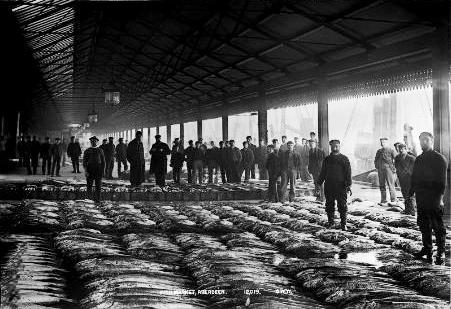Aberdeen Fish Market
Old Fish Market – 88 Shiprow.
Much was done to displace the Shiprow Fish Market (2nd) as a foul-smelling nuisance as it had also previously been in Castle Street no doubt to take advantage of the convenient & valuable Site for re-development. It was then moved to the Poynernook area pro temp but once Steam Trawlers were introduced the Fish Market facility had to be Scaled up.
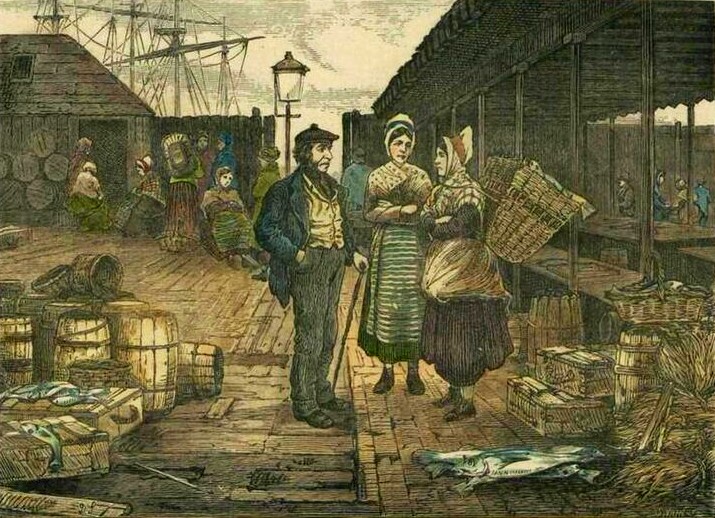
Shiprow Market was replaced by a new Post Office later to become the Unemployment Bureau – The Bru and is now a brightly cleaned Commercial Office at the bottom of Market Street gradient. Note the ubiquitous Bun & long dress for warmth with basic Pinafores. Creels, Baskets, Coopered Barrels & Troughs await the issue from nimble fingers as Fish were dressed by these clootie-fingered ‘cleckin’ women in all weathers. It was a brave man who stepped into this feminist throng & was at considerable personal risk of ridicule, scrutiny & relentless sexual harassment.
Herring Fishing 1883 PDF File
The Covered Fish Market
The old Fish Market was again displaced from the bottom of Shiprow to the Albert Basin & ran the length of Commercial Quay with a full girth of about 2000ft round to Albert Quay, to service the now booming Fishing Industry c.1900s. Two Pontoon Docks for Repairs are clearly visible & beyond further Berthing & Landing areas at Point Law.
Owing to the great development of the Fishing Industry in Aberdeen – due to the introduction of Steam Trawling – more space & better facilities were required for the Landing & Selling of the Fish. The Town Council, who hold the Right of Market, therefore Leased from the Harbour Commissioners the Site at the Albert Basin & erected the 4th Fish Market Site, the 1st portion of which was Opened on 20th May 1889. Since that date the Market had been twice extended, the last extension being completed in March 1904. The length of the Market is 2,012ft, being 427ft to Market Street & 1,585ft to Commercial Road, 1,005ft of which was 35ft wide & the remainder 50ft. This is exclusive of the Wharf, which was built by & belongs to the Harbour Commissioners, & is from 10 to 15ft wide. The Floor Space is 85,120 sq ft & including the Wharf, about 93,000 sq ft. The total cost of the Building, exclusive of the Wharf, Was £21,174. Within the Building is the Superintendent’s Office & also Accommodation for a Sub Post Office, where all Post Office Transactions can be done, including Telegrams. There were also Refreshment Rooms & 1 or 2 Tooms Let for Offices.


Prior to the Building of the Covered Market in 1889. Steam Trawling for White Fish was introduced into Aberdeen in 1882 & Fish were Landed at Point Law. Crews of Fish Gutters at worked ‘Ponds‘ in the Open Air. The Shiploads of Barrels full of Salted Herring were made ready for Export to the Baltic. In a few years, the Fleet of Vessels grew to number several 100 & a flourishing New Industry was added to the Port. A large Graving Dock for the repair & overhauling of Ships built at the Eastern end of the Albert Basin in 1885, was Demolished in 1924-27 to make way for further extending the Covered Fish Market. it looked for all the world like a giant Railway Canopy.
It seemed well Designed with at 1st Sliding Loading Doors & was ramped for Drainage & easy Loading of Vehicles for swift Transport of the potentially deleterious Produce from the North Sea & the North Atlantic. It had a Central Canteen which was Open to All & Sundry & a great source of cheap sustenance & casual entertainment by visiting Performers to the City Theatres. Fish Market Porters wore magnificent high Leather & wood clog boots with Copper Capping & Brass Rivets for sure footing on the Fish Slimed Screeded Concrete Surfaces on which the Boxes of Fish & larger Fish themselves were manoeuvred using Long Steel Gaff Hooks to drag them across the Screed to the Loading Bays. The Wooden Fish Boxes were recycled & washed by the Aberdeen Box Pool Ltd & many had the name Joe Little branded on the surface. There were also Large trolleys that young Louns used dangerously as monumental steel wheeled ‘cairties’ when the Market was over and they could easily have ended up in the tidal Harbour with their fearless & unsupervised exploits within the wide free space of the Linear Fish Market Concourse. (Inset Photo 1949). Once Unloaded the Trawlers would Berth at Point Law for re-Coaling, re-Fuelling, Ice loading, Provisions & Repairs while the Crews enjoyed a raucous rest & recuperation Period Onshore for 3-days or so. They inevitably had to be dragged from their Beds both Drunk & Incapable by Taxi’s to their Cabin Berths to sober up on the way to the Fishing Grounds. A Trawlerman’s Trade was some 14-times more dangerous than that of a Coal Miner.
Bring in the Catch – During the heydey of Aberdeen Fish Market, it wasn’t unusual for the floor area to fill up with boxes 3 times. The Trawlers were lined up 2 & 3 deep, ready to have their Haul unloaded. Experienced (Humpa) Lumpers would be down in the Hold, filling Baskets which were attached to a Crane Winch Pulley System & Hauled up to the Quayside Market Floor. The men on the Quayside would pack the Fish into the 1-cwt boxes ready for the Business of the day; the Selling & Buying of Tons of Fish. Every day there is an inspection by the Government Department of Fish & Agriculture. The Staff from the Research Laboratory would appear in their shiny White Boots & sparkling White Coats & take sample Fish from random Boxes. They would measure, weigh, and take a small sample back to their Lab for testing. The Lumpers would tease them about getting their hands dirty & be telling them to get a ‘Real’ job, but they did a necessary Service to the Industry & no-one resented them.
Aberdeen Fish Market. Boxes of Fish await Inspection, Auction Bid & Purchase by Fishmongers & Merchants. c.1910
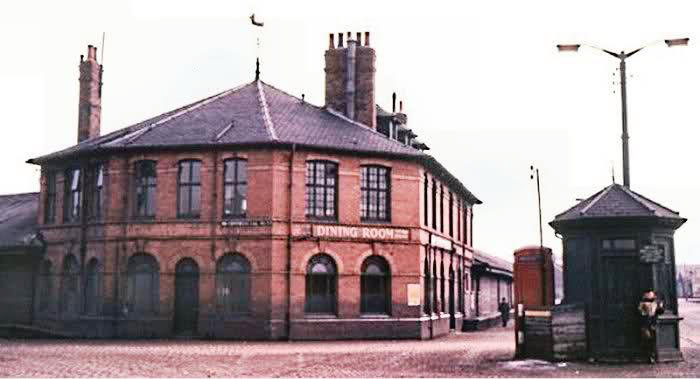
Kiosk Guide Lady: My day didn’t start until about 8-am when I walked down the Market towards my Kiosk, which was in the middle of the Longside. The Sales would have already started by this time, with chaotic order happening all along the Floor. It looked as if the Salesmen are striding around on the top of the Fish, but in fact, each box has an inward lip of about 3-ins which makes a splendid platform for the Auctioneer to conduct their Business. As I walk down the Market, trying not to get in the way of anyone, the Men call out, ‘Late again, Sweetheart! Come on, get the Coffee on!’ & I smile and wave, knowing most of them would have had a huge Breakfast in the Market Café before starting work on the Market Floor. The other reason for the Kiosk was to receive Phone Calls from the different Fish-houses which are in the area. These were the days before Mobile Phones so I would announce over the Tannoy System that someone needed to Contact their Office. Probably there was a change in the demand for 1-Type of Fish or another. Previously it would have been the Job of a young boy to get on his Bike, Pedal like Fury to the Market, then try & find his Contact to pass on the Message, which was a hit-&-miss way of conducting Business, to say the least. Now, when the Buyer heard his name, he made a dive for the nearest Telephone Box (and there were many sited over the length of the Market), to get his New Instructions. The Fish Market was on the list of Visitors’ ‘Things to Do’ & before the Kiosk opened, they would often get in the way of the Business of Selling & Buying Boxes of Fish, so my Dad put up the idea of a Kiosk & a Guide – that was me! That was the part of my job I loved best; taking Visitors along the Floor, pointing out different types of Fish, telling how to identify each one such as the Haddock which has a ‘fingerprint’ just behind the gills. St Peter’s Thumbprint. Cod, when it is laid out in huge shoals on the Floor have a green tinge on the Scales along their back, so is easily identified. When there was something out of the ordinary Landed, such as a Shark, or Octopus, or a huge Monkfish, or a massive Skate, I let the Visitors touch the back of a Shark & feel the roughness of the Skin. Or we examine the Suckers on the Octopus Tentacle or admire the ugliness of a Monkfish & its sharp teeth. When children, Dad would often bring home a Squid or small Octopus & we would take it to School to show the Teacher. Visitors often complained about the smell, but I would soon put them straight, explaining that was the Smell of Money!
When the Selling had surrounded my Kiosk I was kept busy giving out Change for the Phone, selling chocolate biscuits to go with the Coffee from the Machine & generally keeping up with the teasing & joking from the 200 men who would pass by in the space of 15-20 minutes. Usually, each Buyer had a regular Order for what Fish to Buy. The Salesman knew who wanted Haddock or Cod or Mackerel for example & could anticipate the raising of the eyebrow, or the slight movement of a shoulder or hand which indicated a Bid. The Buyers would stand around the Catch which was on offer, staring at the Boxes, shuffling their feet, waiting for the Salesman to call ‘Sold!‘ & then they would move in, slapping their Identity Tickets all over the Catch & move on to the next Lot.
The Tickets were there for the Fishhouse Driver to know which Boxes to hook out & Load onto the Lorry, to be taken back to the Fish-house where the women were waiting to gut & clean the catch, ready for distribution to Shops, Hotels, Restaurants & in some cases getting them ready for going by Train to London. The cleaned & Gutted Fish, which had been checked for quality, were packed into Boxes again, surrounded by loads of Ice, then the top nailed on & they were stacked on the Lorry again to be taken to the nearby Rail Depot where the Train for London would be waiting. The Train left Aberdeen at 2-pm, no waiting for anyone, so the activity around the Gutting Tables became more frantic as the morning wore on. These Fish had to be on the Market at Billingsgate by 5-am the following day & if the Buyer had been unlucky enough to Buy from the last Lot, there wasn’t much time to do the preparation. During the days when Horses were used to pull the Waggons around the Market Area, it wasn’t unknown for a Cart to ‘Accidently’ Tip after Unloading, which enabled another Driver to get his Load on to the Train while the Cart was being set Upright.
One of the perks for Fish Workers at all levels was the traditional Friday Fry. The Market was closed on Saturday & Sunday, so a package of Fish, wrapped in Newspaper was given to each Worker for their Family. In our House, we were used to having Fish 4-nights out of 7 so it wasn’t a treat for us, but many Families welcomed this Right & would eat well on a Friday Night. As the morning wore on, my Duties were to clean & refill the Coffee Machine, count up the Money, make sure the Kiosk was clean – I would have been in & out all the time, attending to the Machine, taking Visitors around, wiping the shelves around the Kiosk & would have been bringing Fishy ‘glaur’ or glue in, so it was down on my knees and scrubbing the floor before I left for the day. Every day was fun on the Fish Market, with 400 men milling around how could it be anything else. Over the years I’ve had many jobs, but the Market stays one of the best. – Lesley P Lyon
Large Fish Species were arranged in neat Rows directly on the Floor & smaller Fish in Boxes
One of the Steel Wheeled Bogies or Trolleys is just off to the left of these mysterious monsters from the deep. The Fishwife appears to have wooden Clogs for sure-footing. The sloping surface run with slippery gut slime & fish scales making walking very difficult & one slip would ensure a smelly coating on clothes. Then the Market was lit by Gas Lamps.
A good Catch indeed with eager Buyers & Children swarming around and standing on the Fish Box edges for a better view. Above the Roof can be seen the Citadel in the distance through the Trawler Rigging. The Slime that was ever-present on the Floor was Hosed away at the end of the Sale leaving the Market pristine for the next day. In the Crook of this view is the Fish Market Canteen. A Bogie lies by the Quay Deck. Fedora’s, Caps & ‘Bunnets‘ abound on Spectators heads. Sadly no close-up of Market Porters Clogs to be admired. Sunlight was not meant to fall on the Fish & induce putrefaction, only Northlight hence the very sparse illumination.
Market Dining Rooms Centre – Coal Lorries one of which is Steam Driven at Palmerston Quay which ran across the end of Albert Basin
When the Market was over by early afternoon one would occasionally find a 6ft Conger Eel a scary monster of the deep, lying forgotten in a corner of the Floor. When kicked it would appear to retain some life as it thrashed lifelike across the wet surface striking sudden fear in the hearts of adventurous wee Louns playing unsupervised in the wide free space of the empty Covered Market. c.1946
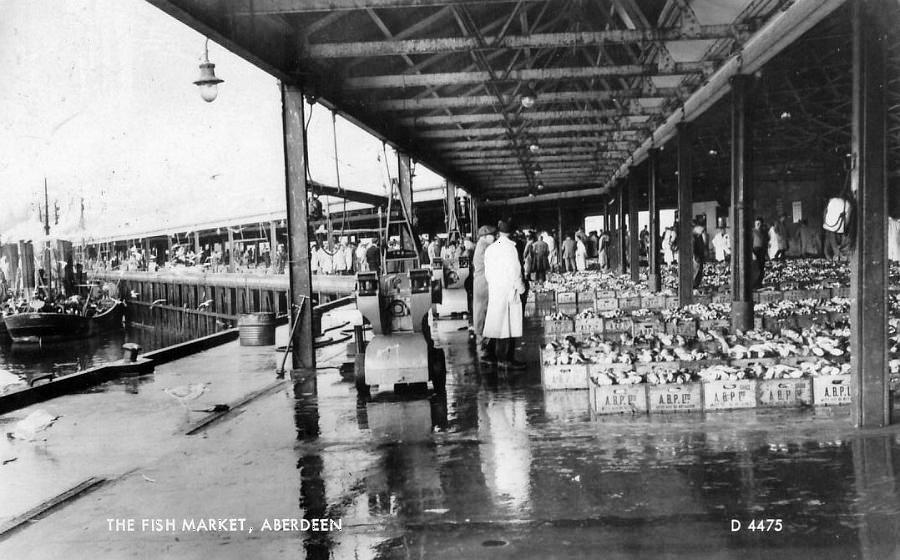
Electric Lights & portable Winches have been added and the white-coated Auctioneers abound among the Fish Merchants and curious onlookers. When sold the Buyer’s paper identification labels would be placed on the wet fish sold for collection by waiting lorries or horse-drawn carts. Porters would walk along the edges of the wooden fish boxes to do this. Seagulls would be ever-present scavenging for a chance meal conveniently dropped or landed on the Quay and this began their demise as cliff dwelling ocean-going Birds and they evolved into verminous & aggressive City muggers. A cruel prank by louns was to fill a Fish with discarded carbide and throw it to the Seagulls. Carbide gave off a flammable gas when immersed in water and the Bird would surely die. Stand taps were by most external stanchions for hosing down the Market Floor after the Business of the day was over.
An incongruous ‘H‘ chimney protrudes from the Trawler Galley to avoid asphyxiation from Stove Fumes in windy seas. Inverted ‘U‘ shaped Gallows frames are evident Starboard side for Trawling the Dragnets behind the Fishing Trawlers. High Forecastles stand proud of the Landing Quay, ¼ Cran Baskets & sometimes Barrels were a link with past methods of carrying Fish in Bulk. Lorries with Barrels of Ice were on hand which were sprinkled liberally over the Fish to help preserve them in Transit at Sea & subsequently in Road or Train transport to other distribution points like Billingsgate, London.
Neatly Regiment Fish species Awaiting Auction.
Roofscape & Point Law Berth for Steam Trawlers moored up for the weekend before the mad jockeying to clear the Harbour Bar on Monday mornings.
23rd February 1923 – ‘Herren’ Wars
Aberdeen Market was the scene of a Bitter Strike Action in 1923 involving 350 Steam Trawlers & Crews.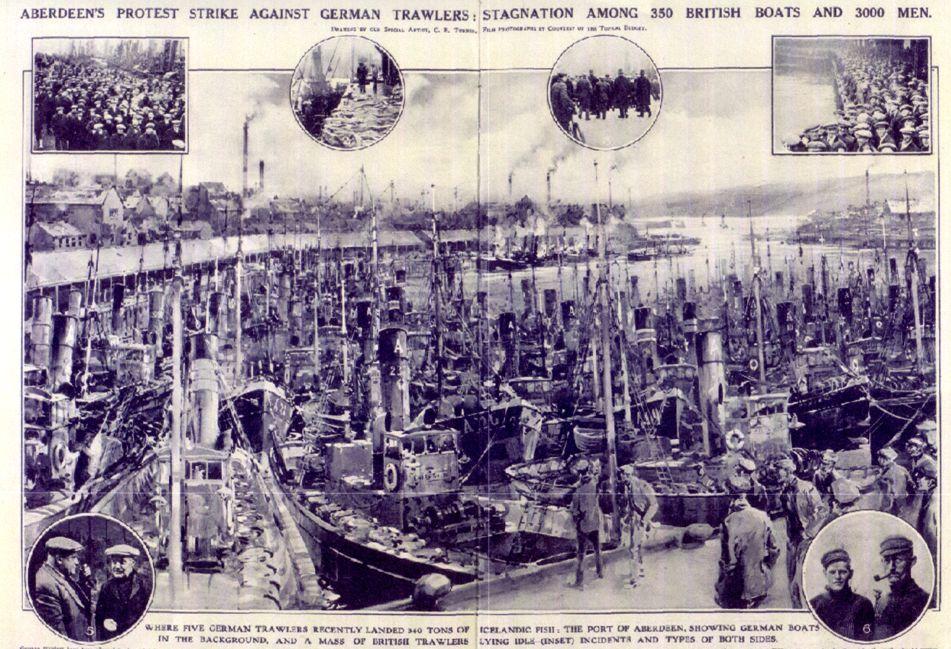
A regular invasion of German Trawlers challenged the Fishing Industry of Aberdeen but this menace has been removed by the British Trawler-owners & Skippers having prevailed on the Auctioneers not to sell Fish Landed by German Vessels Fishing in the North Sea. The British Trawlermen went on Strike till the Landing of Fish from German Trawlers was stopped. The Skipper of a German Trawler who proposed to discharge his large catch of Fish was told to take his Fish to Germany This decision did not affect German Catches made in Icelandic Waters, which were mostly brought to Aberdeen to be Cured. The Fishing Strike in Aberdeen was due to the Landing by German Trawlers of Fish caught under the Local Fishermen’s noses in the waters formerly Fished by British Fishermen. German Trawlers were being allowed to Fish off the Coast of Scotland when British Trawlers were precluded from a 3-mile limit. No Settlement of this serious Strike at Aberdeen was likely to take place as long as these conditions existed.
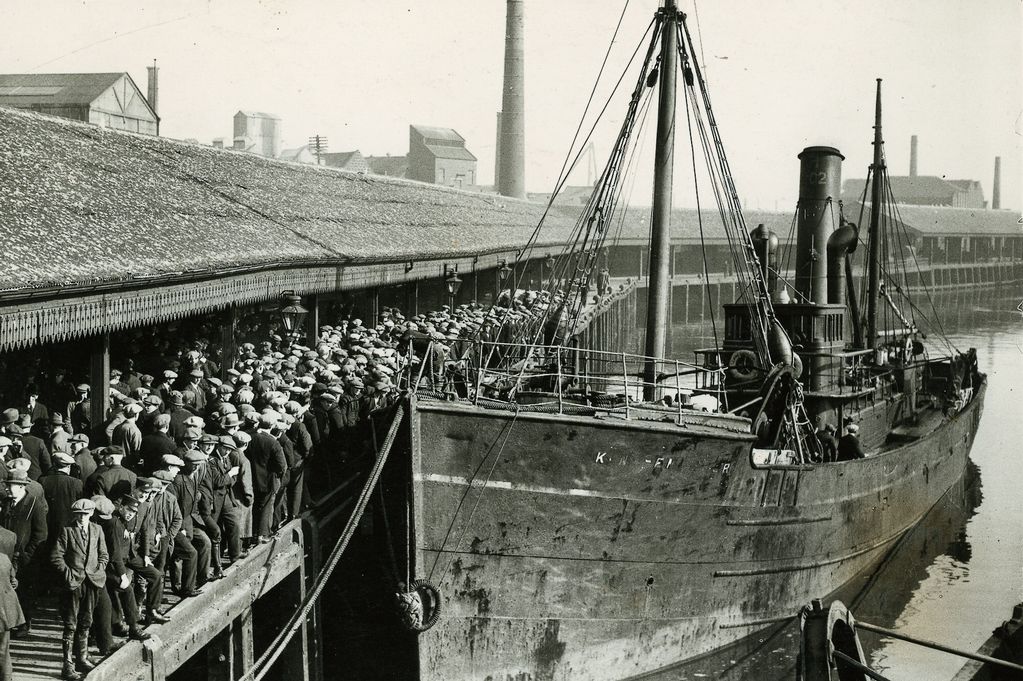
The Else Kunkel ll German Trawler Crew faces a hostile Crowd at the Fish Market in 1923
The Fish were not caught, in the main, in Icelandic Waters, but in waters where no British Trawler was allowed to Trawl legally & that this was a grave injustice to Scottish Fishermen. This situation was affecting the whole of the Trawling Industry, Illegal & Legal, around the Coast of Scotland & that the Action at Aberdeen was merely bringing the matter to a definite issue.
Some 3000 Trawlermen & sympathisers went on Strike for about a month and a near riot took place when Ice & Fish were thrown at the German Crewmen & one German Trawler’s Catch was Dumped in the Albert Basin. German Trawlers were also unmoored & cast adrift, Market Porters were beaten up for moving the Fish & there were Police Baton Charges after suitable Reinforcements arrived. There were concerns about whether the Germans were reaping the benefit of recent Legislation to preserve Fish Stocks by Landing Coastal Water Fish rather than the formerly acceptable practice of Icelandic Waters Fish being brought here for Curing only.
The Harbour area was my Playground & certain Ships & Factories would need Daily Inspection to see what was new & going on. Woodpiles were our ‘Bouncy Castles’ as long ends of springy timber stuck out to provide ready Springboards. We would dare each other to run over Stinking Cowhides piled on the Quayside without falling over on what may have been Anthrax-laden Slime. An appealing but distant chat with the Esparto Grass Ships Crew to see if they had found any Tortoises on board. Then a jaunt through the Fish Market to pinch some Herring or odd fish for ‘Tibsy’ our House Cat as we slithered about unsuccessfully on our ‘Gymmies’ in the Slime of Fish scales & doubtful gut juices; each wishing we had a pair of those admirable copper-clad wooden clogs the Porters wore for good footing adhesion. All in a day’s Play.
The “Cran” Box Measure was approximately 170.5 ltrs, which was adopted as the Official measure in 1796 for uncleaned Herring & was equal to about 1,000 Herring. the Baskets used to convey the Herring from the Boats to the Shore were known as “¼ crans” & carried the Official Brand of Certification. This method of unloading speeded up the whole gutting process, as compared to the English method of counting individual Fish. Each finished Barrel of gutted & salted herring would contain between 1000 & 1200 Herring depending on the Grade of Herring.
Regimented Foremast Derricks were the previous method of Landing Fish from the Iced Hold Ponds in Basket Creels for dispersing neatly in rows on the Sales Floor or into Cran Boxes for Auction & for Sale to the highest Bidder. Adverts & information adorned the outer wall of the Fish Market with Adverts to inform the Public of the Fish Species Landed & or the Market Byelaws. The Quay Deck Surface was Chevron scored for ease of drainage & improving foothold. Undersize Fish landed would be condemned for Fishmeal use only to discourage future Catches of small Fish & preserve the falling Fishery Stocks from further plunder.
Recent but now displaced by the Oil Service demands on Aberdeen Harbour. Tommy Hunter was one of the few Fishmongers locally with a Wet Fish Shop in Upper George Street to endeavour to sell fresh Fish to an already well-connected Community that always had regular access to a Free ‘Fry’. – hey Alec – are ye wit’n a fry, Min!
The Strathallan 1972 – victim of a spring Tide in the Fishmarket Harbour. The Trawler was trapped under the Quay during a rising Tide.. She Sank & took an adjacent Trawler George R Wood with her. Both Vessels were raised & the Strathallan was Sold for Scrap & the George R Wood returned to Fishing.

